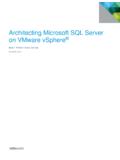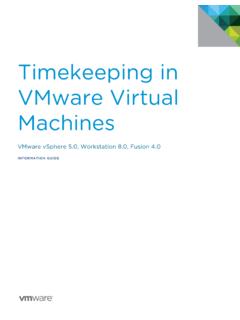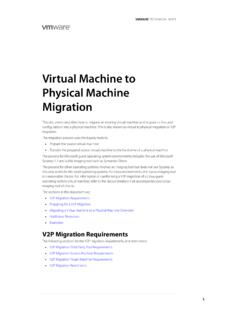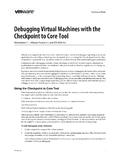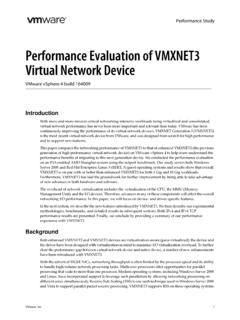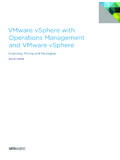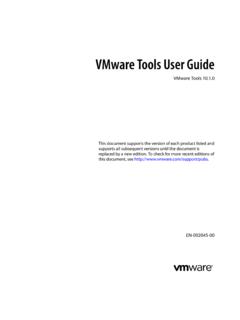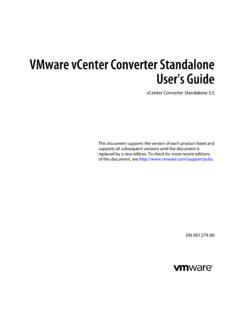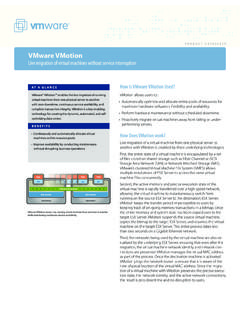Transcription of VMware vSphere with Kubernetes 101
1 VMware vSphere with Kubernetes 101 An Introduction for vSphere Administrators 2 VMware vSphere with Kubernetes 101: An introduction for vSphere Administrators Table of Contents Introduction 3 Goals 3 What is Kubernetes ? 3 What is vSphere with Kubernetes ? 4 What components make up a Kubernetes Cluster? 4 How does vSphere with Kubernetes work? 5 Advantages for the VMware Administrator 6 What comes with vSphere with Kubernetes ? 6 Supervisor Cluster .. 6 Tanzu Kubernetes Cluster .. 6 vSphere with Kubernetes & Cloud Foundation Services .. 7 VMware NSX .. 7 Tanzu Kubernetes Cluster or Supervisor Cluster: Which do I choose? 8 The Best Way to Get Started: VMware Cloud Foundation 8 Conclusion & Takeaways 9 Resources 10 3 VMware vSphere with Kubernetes 101: An introduction for vSphere Administrators Introduction If you spend time in the information technology world you ve likely heard the word Kubernetes , often in conjunction with containers and developers.
2 Containers first started on Linux in 2008 and are a lightweight & portable way to distribute and run applications across operating systems and clouds. Containers are not virtual machines, and by being lightweight they don t have the same well-defined boundaries security, performance, or even political that virtual machines have. As you might expect, this has both challenges and advantages. Containers can be incredibly useful for developing applications. Kubernetes was created to help manage many of the challenges around deploying those applications, most notably by helping automate and orchestrate deployments and availability. Kubernetes itself is an open-source project, governed by the Cloud Native Computing Foundation. VMware contributes heavily to the open-source Kubernetes software base and is deeply involved in Kubernetes communities and governance.
3 Kubernetes is extremely API-driven, which lends itself well to automation. It is very appealing to application developers as they seek to implement modern development practices, with short or continuous development cycles, well-defined APIs, and clearly separated and defined services which are often referred to as microservices. vSphere and Virtual Infrastructure administrators often find themselves positioned between developers seeking to implement modern application development practices and more traditional IT infrastructure and governance rooted in decades of practice. This guide is intended to help admins understand what vSphere with Kubernetes is, how it helps build bridges, and how to get started with this new and exciting form of infrastructure for modern, cloud-native applications both on-premises and in public clouds. Goals At the end of this document it is our goal that you will understand: What VMware vSphere with Kubernetes is The value that a Kubernetes Namespace brings to both the VMware Administrator and developers The differences between a Supervisor Cluster and a Tanzu Kubernetes Cluster How to get started with vSphere with Kubernetes & VMware Cloud Foundation Services What is Kubernetes ?
4 According to , Kubernetes is a portable, extensible, open-source platform for managing containerized workloads and services, which facilitates both declarative configuration and automation. It has a large, rapidly growing ecosystem. Kubernetes services, support, and tools are widely available. What does that mean to a VMware Administrator? Kubernetes is an innovative approach for orchestrating the deployment and ongoing lifecycle management of modern, container-based workloads. Perhaps a brief history of the different approaches to application deployment will help aid our understanding of how Kubernetes fits in the modern enterprise: Traditional Deployment Applications and workloads deployed directly to physical servers are considered traditional deployments. Deployments of these types tended to be inflexible, hard to scale, and wasted costly resources by trapping them on specific systems.
5 Virtualized Deployment VMware ESXi, a hypervisor, adds a layer of abstraction that allows for the creation of virtual machines which mimic the functions of a standardized physical server such that a workload does not know it is not running directly on a physical server. Each virtual machine has its own set of allocated resources as well as an operating system and can provide isolation of resources from other virtual machines. VMware ESXi also provides numerous availability features like vMotion, Dynamic Resource Scheduling, High Availability, and more, all of which provide massive advantages over traditional workload deployments. Containerized Deployment Containers are like VMs but are lightweight and do not have the rigid boundaries that VMs have. This makes them more portable and agile within a family of guest operating systems (such as Linux). A container s operating system comes from the system the container is running on and is shared among all containers running on a host.
6 However, containers have their own filesystems and resource 4 VMware vSphere with Kubernetes 101: An introduction for vSphere Administrators allocation mechanisms. Containers are popular because of the ability to have continuous development and integration for deployment, a capability made possible by their lightweight nature. What is vSphere with Kubernetes ? VMware vSphere with Kubernetes was announced at VMworld 2019 as Project Pacific. It adds Kubernetes capabilities to vSphere in ways that respect the traditional experiences of both developers and vSphere Admins. To a developer, vSphere with Kubernetes looks and acts like a standard Kubernetes cluster. Their tools and processes work across implementations. They can use the Kubernetes declarative syntax to define what resources they need, such as storage, networking, and even relationships & availability requirements.
7 By using the industry-standard Kubernetes syntax they don t need direct access to, or knowledge of, the vSphere APIs, clients, or infrastructure. To a vSphere Admin, vSphere continues operating just as it has for decades but now with new workload management features to better meet the needs of developers. Management of vSphere is still done through the vSphere Client, PowerCLI, and APIs, as it has been done for years. vSphere Admins can deploy namespaces the Kubernetes term for managing resources and policies and manage the security, resource consumption, and networking capabilities available to the developers. vSphere with Kubernetes provides a unified approach to infrastructure that is uniquely suited for hosting both traditional workloads, and modern, cloud-native applications. For application developers, it is Kubernetes . For vSphere administrators, it is vSphere .
8 For the business, it is a consistent, standardized approach for deploying and managing traditional workloads alongside modern, cloud-native applications, while safeguarding the security, compliance, and control of the IT infrastructure. What components make up a Kubernetes Cluster? There are many components that are part of a Kubernetes Cluster. Here is an explanation of the ones relevant to deploying and configuring vSphere with Kubernetes : Nodes There are two main node types in Kubernetes , a Master and Worker. A master node is a management node, what you would expect of vCenter Server. A worker node is what you would expect of an ESXi host, allowing you to run Pods. Pod A Pod is a group of one or more containers. If we map this to a VMware Administrator construct think of Pods as an object similar to a virtual machine. Pods are managed by the Kubelet that runs on each node.
9 Kubelet watches Podspecs assigned to it and handles all lifecycle by comparing actual Pod state to the desired state stored in the Podspec. 5 VMware vSphere with Kubernetes 101: An introduction for vSphere Administrators Storage The files stored within a container are ephemeral, which means on each container restart the data is lost. This is both an advantage and disadvantage. If you wish to have data be persistent it must be stored in a persistent volume. There are many different types of volumes available to Kubernetes . VMware vSAN has native container storage capabilities, allowing workloads to mount persistent volumes inside the VMware Cloud Foundation deployment. vSphere Cloud Native Storage provides the capability to back Kubernetes persistent volumes with vSphere volumes. The CNS provider supports VSAN and any other VMFS based datastore. Namespace A Namespace is used as the unit of management in environments with many users across multiple teams or projects.
10 Namespaces are a way to divide cluster resources and separate permissions between users. When a Namespace is created you assign CPU, Memory and Storage limits to restrict the amount of resources a workload can consume, not unlike a vSphere Resource Pool. Where Namespaces differ from Resource Pools is that they also incorporate controls such as security. For example, from a security perspective via Namespaces you can manage access controls by using edit or read-only groups. You also have the ability through security policies to limit ports, audit changes and force encryption of data. To encrypt all containers and/or VMs in a Namespace is done by setting one property rather than going to each VM and encrypting individually. How does vSphere with Kubernetes work? vSphere with Kubernetes introduces Kubernetes APIs as a new Developer API that provides a cloud service consumption experience analogous to what they would get in a public cloud while providing a new control plane, or management interface, for vSphere via the extended Namespace construct.
